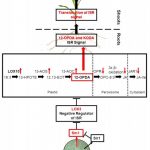Plant Science Research Weekly: November 15
Review: Genetic strategies for improving crop yields
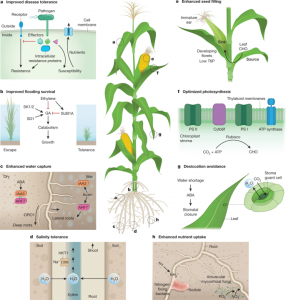 Simply put, as food demand increases due to population growth and increased affluence, crop yields are likely to decrease due to the changing climate. Plant scientists will be familiar with many research avenues that aim to address this disconnect, ranging from increasing crop resilience to abiotic stresses, improving nutrient use efficiencies, and decreasing loss to pathogens. These and other topics are covered in this excellent, free perspective written by leading scientists, which focuses on genetic approaches to addressing crop productivity. This is an excellent article to share with students, funders, policy makers and the curious public. (Summary by Mary Williams) Nature. 10.1038/s41586-019-1679-0
Simply put, as food demand increases due to population growth and increased affluence, crop yields are likely to decrease due to the changing climate. Plant scientists will be familiar with many research avenues that aim to address this disconnect, ranging from increasing crop resilience to abiotic stresses, improving nutrient use efficiencies, and decreasing loss to pathogens. These and other topics are covered in this excellent, free perspective written by leading scientists, which focuses on genetic approaches to addressing crop productivity. This is an excellent article to share with students, funders, policy makers and the curious public. (Summary by Mary Williams) Nature. 10.1038/s41586-019-1679-0
Review: Soil compaction and the architectural plasticity of root systems.
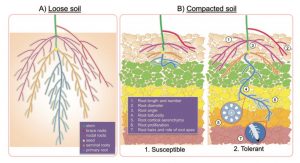 Root system architecture (RSA) describes the spatial arrangement of root components within the soil. RSA is useful to understand the exploration of the plant to get nutrients and water through the soil space. In a new review, Correa et al. discuss RSA plasticity in response to soil compaction, which is the process where the distance between the soil particles is minimal. Soil compaction causes a reduction of root growth, length and proliferation and increases the diameter and number of roots. It also affects root angle, root tortuosity, and root hair growth, as well as the root-to-shoot ration. The authors evaluate whether the changes in RSA are due to growth inhibition (“apparent plasticity”) or confer advantages (“adpative plasticity”). Adaptive plasticity of RSA might be of great value for breeding plants that are more tolerant to soil compaction. (Summary by Mugdha Sabale) J. Exp. Bot. 10.1093/jxb/erz383
Root system architecture (RSA) describes the spatial arrangement of root components within the soil. RSA is useful to understand the exploration of the plant to get nutrients and water through the soil space. In a new review, Correa et al. discuss RSA plasticity in response to soil compaction, which is the process where the distance between the soil particles is minimal. Soil compaction causes a reduction of root growth, length and proliferation and increases the diameter and number of roots. It also affects root angle, root tortuosity, and root hair growth, as well as the root-to-shoot ration. The authors evaluate whether the changes in RSA are due to growth inhibition (“apparent plasticity”) or confer advantages (“adpative plasticity”). Adaptive plasticity of RSA might be of great value for breeding plants that are more tolerant to soil compaction. (Summary by Mugdha Sabale) J. Exp. Bot. 10.1093/jxb/erz383
Review: An evolutionary history of genes controlling carpel development
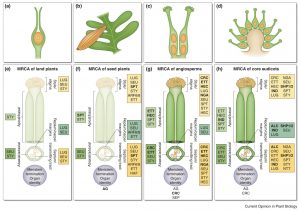 Carpels, the female reproductive structures in angiosperms, are the most complex organs in plants. Most of the current knowledge about the molecular mechanism underlying carpel development derives from Arabidopsis. In a new review, Becker summarizes recent studies about the reconstruction of ancestral carpels. Through phylogeny analysis, the lineages of genes and modules within the Arabidopsis Gene Regulatory Networks (GRN) can be traced through the evolution of plants. This strategy allows the identification of ’old’ and ‘young’ genes, sometimes related to morphological or developmental features. The author proposes the carpel GRN of the most recent common ancestor (MRCA) of land-plants, seed-plants, angiosperms, or core eudicots. Some genes that have prominent roles during carpel development are present in all land plants, for instance, SEUSS, LEUNIG, and STYLISH genes (involved in the regulation of auxin biosynthesis). Genes controlling meristem determinacy and carpel identity (such as AGAMOUS and SEPALLATA), can be detected in the MRCA of seed plants. In this case, the auxin signaling network becomes more complex with the addition of some ARF (ETTIN), and bHLH transcription factors, such as SPATULA. The origin of angiosperms marks the origin of essential genes involved in tissue polarity (CRABS CLAW) and genes that participate in the formation of style and stigma (NGATHA). Finally, some other genes are present only in core eudicots, i.e., INDEHISCENT and ALCATRAZ controlling the development of the dehiscence zones in the fruit. The author also discusses how these proposed GRNs of ancestral carpels can help our understanding of the origin of this reproductive structure. (Summary by Humberto Herrera-Ubaldo) Curr. Opin. Plant Biol. 10.1016/j.pbi.2019.08.009
Carpels, the female reproductive structures in angiosperms, are the most complex organs in plants. Most of the current knowledge about the molecular mechanism underlying carpel development derives from Arabidopsis. In a new review, Becker summarizes recent studies about the reconstruction of ancestral carpels. Through phylogeny analysis, the lineages of genes and modules within the Arabidopsis Gene Regulatory Networks (GRN) can be traced through the evolution of plants. This strategy allows the identification of ’old’ and ‘young’ genes, sometimes related to morphological or developmental features. The author proposes the carpel GRN of the most recent common ancestor (MRCA) of land-plants, seed-plants, angiosperms, or core eudicots. Some genes that have prominent roles during carpel development are present in all land plants, for instance, SEUSS, LEUNIG, and STYLISH genes (involved in the regulation of auxin biosynthesis). Genes controlling meristem determinacy and carpel identity (such as AGAMOUS and SEPALLATA), can be detected in the MRCA of seed plants. In this case, the auxin signaling network becomes more complex with the addition of some ARF (ETTIN), and bHLH transcription factors, such as SPATULA. The origin of angiosperms marks the origin of essential genes involved in tissue polarity (CRABS CLAW) and genes that participate in the formation of style and stigma (NGATHA). Finally, some other genes are present only in core eudicots, i.e., INDEHISCENT and ALCATRAZ controlling the development of the dehiscence zones in the fruit. The author also discusses how these proposed GRNs of ancestral carpels can help our understanding of the origin of this reproductive structure. (Summary by Humberto Herrera-Ubaldo) Curr. Opin. Plant Biol. 10.1016/j.pbi.2019.08.009
Essay: Reconstructing trait evolution in plant evo–devo studies
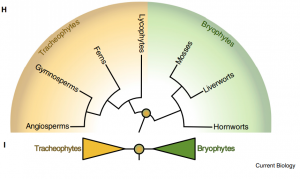 Plant evo-devo studies are thriving thanks to new genetic engineering tools and the emergence of model systems such as the moss Physcomitrella patens, the liverwort Marchantia polymorpha, and the fern Ceratopteris richardii. In the past few years many debates have taken place among the community, in particular about how to draw evolutionary comparisons between species. In an effort to “simplify” evolution for a broader audience, misleading concepts like “ancient”, “basal”, or “primitive” vs “higher” plants are abundant in the literature. Pierre Marc Delaux brought together a group of top scientists in plant evo-devo to discuss in an essay many of the controversies in this scientific field. Here, they discuss the way we think trait evolution and its molecular mechanisms and how to make better inferences about them. They also provide stepwise guidelines for studies in evolutionary biology at different levels, from phylogenetic inference to molecular mechanisms in evolution. This is a must-read for people working on plant evo-devo, in particular for those who are new or want to enter the field. (Summary by Facundo Romani) Curr. Biol. 10.1016/j.cub.2019.09.044
Plant evo-devo studies are thriving thanks to new genetic engineering tools and the emergence of model systems such as the moss Physcomitrella patens, the liverwort Marchantia polymorpha, and the fern Ceratopteris richardii. In the past few years many debates have taken place among the community, in particular about how to draw evolutionary comparisons between species. In an effort to “simplify” evolution for a broader audience, misleading concepts like “ancient”, “basal”, or “primitive” vs “higher” plants are abundant in the literature. Pierre Marc Delaux brought together a group of top scientists in plant evo-devo to discuss in an essay many of the controversies in this scientific field. Here, they discuss the way we think trait evolution and its molecular mechanisms and how to make better inferences about them. They also provide stepwise guidelines for studies in evolutionary biology at different levels, from phylogenetic inference to molecular mechanisms in evolution. This is a must-read for people working on plant evo-devo, in particular for those who are new or want to enter the field. (Summary by Facundo Romani) Curr. Biol. 10.1016/j.cub.2019.09.044
Chromatin organization in early land plants reveals an ancestral association between H3K27me3, transposons, and constitutive heterochromatin & A pseudomolecule-scale genome assembly of the liverwort Marchantia polymorpha
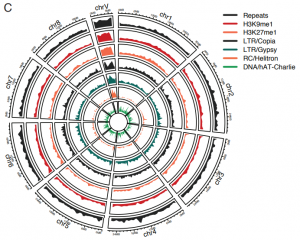 Since the publication of the Marchantia polymorpha genome in 2017, a big update was necessary. In the past week, two groups published on improving Marchantia chromosome assembly following different experimental approaches. Diop et al. made a high-density linkage map using genetic markers obtained by ddRAD-seq, managing to assemble 88% of the genomic DNA content in near-complete chromosomes. On the other hand, Montgomery et al. additionally made Hi-C analysis and achieved to map 98.6% of genomic DNA in chromosomes. Both approaches arrived at similar conclusions about the relative localization of transposable elements (TE) and other gene features. While in angiosperms centromeres are enriched in TE and depleted in protein-coding genes, in Marchantia most gene features are evenly distributed across the chromosome. This also was demonstrated for the model moss Physcomitrella patens, suggesting that this is a conserved feature of bryophytes. Additionally, Montgomery et al. performed CUT&RUN, drawing many interesting conclusions particularly related to H3K27me3 in the spatial and linear organization of the Marchantia genome. Diop et al. instead analyzed the distribution of recombination rates based on crosses with a Switzerland accession. In conclusion, both papers offer new insights into how chromosome architecture has evolved in eukaryotes. Additionally, they provide useful genomic resources to the community working with Marchantia. (Summary by Facundo Romani) (10.1101/827881 & 10.1111/TPJ.14602)
Since the publication of the Marchantia polymorpha genome in 2017, a big update was necessary. In the past week, two groups published on improving Marchantia chromosome assembly following different experimental approaches. Diop et al. made a high-density linkage map using genetic markers obtained by ddRAD-seq, managing to assemble 88% of the genomic DNA content in near-complete chromosomes. On the other hand, Montgomery et al. additionally made Hi-C analysis and achieved to map 98.6% of genomic DNA in chromosomes. Both approaches arrived at similar conclusions about the relative localization of transposable elements (TE) and other gene features. While in angiosperms centromeres are enriched in TE and depleted in protein-coding genes, in Marchantia most gene features are evenly distributed across the chromosome. This also was demonstrated for the model moss Physcomitrella patens, suggesting that this is a conserved feature of bryophytes. Additionally, Montgomery et al. performed CUT&RUN, drawing many interesting conclusions particularly related to H3K27me3 in the spatial and linear organization of the Marchantia genome. Diop et al. instead analyzed the distribution of recombination rates based on crosses with a Switzerland accession. In conclusion, both papers offer new insights into how chromosome architecture has evolved in eukaryotes. Additionally, they provide useful genomic resources to the community working with Marchantia. (Summary by Facundo Romani) (10.1101/827881 & 10.1111/TPJ.14602)
ATP binding cassette proteins ABCG37 and ABCG33 are required for potassium-independent cesium uptake in Arabidopsis roots
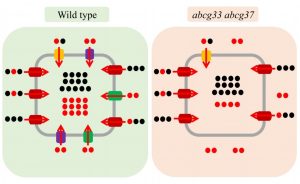 Potassium is one of the major nutrients for plant growth and development. Plants have a well-studied potassium uptake system mediated by transporters and ion channels. Unfortunately, due to the chemical similarity of potassium and cesium, which is toxic for plant growth, cesium is able to to get into the plant system and eventually into our food chain. This problem is exacerbated by radiocesium, which has a half-life ranging from two to thirty years. Nuclear power plant incidents such as Chernobyl (1986) and Fukushima (2011) release radiocesium, putting land and health at risk. Here, the authors tried to find cesium-specific transporters without altering potassium uptake of the plant in order to develop a phytoremediation approach. They demonstrated that two ABC transporters, ABCG37 and ABCG33, redundantly function as cesium uptake carriers. More importantly, in this double knockout mutant, potassium levels remains same. Using a radiocesium transport assay in planta, they have demonstrated less radiocesium uptake in the Arabidopsis thaliana roots. This finding is consistent with their physiological, genetic, molecular, and bioinformatics evidence. (Summary by Arif Ashraf) bioRxiv 10.1101/823815
Potassium is one of the major nutrients for plant growth and development. Plants have a well-studied potassium uptake system mediated by transporters and ion channels. Unfortunately, due to the chemical similarity of potassium and cesium, which is toxic for plant growth, cesium is able to to get into the plant system and eventually into our food chain. This problem is exacerbated by radiocesium, which has a half-life ranging from two to thirty years. Nuclear power plant incidents such as Chernobyl (1986) and Fukushima (2011) release radiocesium, putting land and health at risk. Here, the authors tried to find cesium-specific transporters without altering potassium uptake of the plant in order to develop a phytoremediation approach. They demonstrated that two ABC transporters, ABCG37 and ABCG33, redundantly function as cesium uptake carriers. More importantly, in this double knockout mutant, potassium levels remains same. Using a radiocesium transport assay in planta, they have demonstrated less radiocesium uptake in the Arabidopsis thaliana roots. This finding is consistent with their physiological, genetic, molecular, and bioinformatics evidence. (Summary by Arif Ashraf) bioRxiv 10.1101/823815
A conserved signaling module controls tip growth in liverwort M. polymorpha and A. thaliana
 Plants have evolved with rooting cells to anchor them to the land and uptake nutrients efficiently. Growth of root hairs in seed plants or rhizoids in early diverging plants both rely on tip growth, which requires a coordination of wall loosening and deposition of wall materials with cell expansion in order to maintain cell wall integrity. Previous studies in Arabidopsis identified that this process depends on two malectin-like receptor kinases (MLRs) acting upstream of a PTI-like kinase. Here, Westermann et al. found that the MLR and PTI1-like signaling module is conserved between M. polymorpha and A. thaliana. MpMRI can replace the function of AtMRI to maintain cell wall integrity during pollen tube and root hair growth. This study proposes a homologous genetic mechanism regulating in the development of analogous structures of land plants. It also suggests that such an ancient common feature was probably shared by most lineages of land plants. (Summary by Nanxun Qin) Curr. Biol. 10.1016/j.cub.2019.09.069
Plants have evolved with rooting cells to anchor them to the land and uptake nutrients efficiently. Growth of root hairs in seed plants or rhizoids in early diverging plants both rely on tip growth, which requires a coordination of wall loosening and deposition of wall materials with cell expansion in order to maintain cell wall integrity. Previous studies in Arabidopsis identified that this process depends on two malectin-like receptor kinases (MLRs) acting upstream of a PTI-like kinase. Here, Westermann et al. found that the MLR and PTI1-like signaling module is conserved between M. polymorpha and A. thaliana. MpMRI can replace the function of AtMRI to maintain cell wall integrity during pollen tube and root hair growth. This study proposes a homologous genetic mechanism regulating in the development of analogous structures of land plants. It also suggests that such an ancient common feature was probably shared by most lineages of land plants. (Summary by Nanxun Qin) Curr. Biol. 10.1016/j.cub.2019.09.069
Understanding pathogenic bacterial gene expression in planta is essential to understand plant pathology
How exactly does the plant defense system target pathogens? Nobori et al. have analyzed interactions 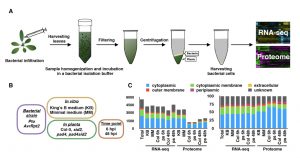 inside the plant between the foliar bacterial pathogen Pseudomonas syringae and Arabidopsis thaliana at transcriptomic and proteomic levels by using RNAseq and liquid chromatography mass spectrometry (LC-MS) during early and later stages of infection. The authors found that the pathogenesis-related processes are highly activated at both stages of infection, and that the comparison between mRNA and protein helped to shed some light on the regulation of these processes. For example, the genes involved in chemotaxis were upregulated at the mRNA level and suppressed at the protein level. Similarly, the salicylic acid pathway was found to selectively target the tip component of the Type III secretion system at the protein level. These data give a guideline to understand the interaction between pathogen and plant by multi omics strategies. (Summary by Mugdha Sabale) bioRxiv 10.1101/822932
inside the plant between the foliar bacterial pathogen Pseudomonas syringae and Arabidopsis thaliana at transcriptomic and proteomic levels by using RNAseq and liquid chromatography mass spectrometry (LC-MS) during early and later stages of infection. The authors found that the pathogenesis-related processes are highly activated at both stages of infection, and that the comparison between mRNA and protein helped to shed some light on the regulation of these processes. For example, the genes involved in chemotaxis were upregulated at the mRNA level and suppressed at the protein level. Similarly, the salicylic acid pathway was found to selectively target the tip component of the Type III secretion system at the protein level. These data give a guideline to understand the interaction between pathogen and plant by multi omics strategies. (Summary by Mugdha Sabale) bioRxiv 10.1101/822932
Overexpression of zmm28 increases maize grain yield in the field
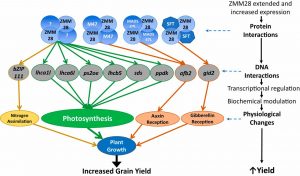 This study, from scientists at Corteva Agriscience, demonstrates a yield boost in transgenic maize overexpressing a gene encoding a transcription factor. Expression of zmm28, a maize MADS-box transcription factor gene, is elevated through fusion to a maize GOS2 promoter, which provides moderate, constitutive expression in all cell types (GOS2 encodes a translation-initiation factor). The authors demonstrate increased yields in numerous field trials: “Over this 4-y period, a total of 48 hybrids ranging in relative maturity from 105 to 113 d were evaluated at 58 locations,” with the zmm28-expressing plants showing a consistently higher yield. Transgenic plants were also larger with more leaf biomass and increased rates of photosynthesis, as well as increased nitrogen uptake assimilation. Transcriptomic analysis as well as ChIP-Seq and yeast one-hybrid analsis identified direct targets of ZMM28, including genes involved in photosynthesis and hormone production and response. The authors conclude that, “alteration in expression of a single native gene in maize, zmm28, can improve both resource capture and resource utilization, resulting in a significant improvement in grain yield, the ultimate complex quantitative trait.” (Summary by Mary Williams) Proc. Natl. Acad. Sci. USA
This study, from scientists at Corteva Agriscience, demonstrates a yield boost in transgenic maize overexpressing a gene encoding a transcription factor. Expression of zmm28, a maize MADS-box transcription factor gene, is elevated through fusion to a maize GOS2 promoter, which provides moderate, constitutive expression in all cell types (GOS2 encodes a translation-initiation factor). The authors demonstrate increased yields in numerous field trials: “Over this 4-y period, a total of 48 hybrids ranging in relative maturity from 105 to 113 d were evaluated at 58 locations,” with the zmm28-expressing plants showing a consistently higher yield. Transgenic plants were also larger with more leaf biomass and increased rates of photosynthesis, as well as increased nitrogen uptake assimilation. Transcriptomic analysis as well as ChIP-Seq and yeast one-hybrid analsis identified direct targets of ZMM28, including genes involved in photosynthesis and hormone production and response. The authors conclude that, “alteration in expression of a single native gene in maize, zmm28, can improve both resource capture and resource utilization, resulting in a significant improvement in grain yield, the ultimate complex quantitative trait.” (Summary by Mary Williams) Proc. Natl. Acad. Sci. USA
A large transposon insertion in the stiff1 promoter increases stalk strength in maize
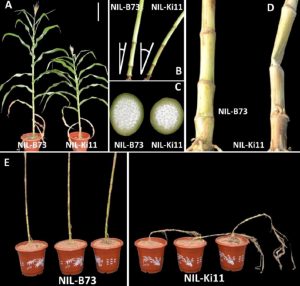 We all know the importance of staying upright, especially for our grass crops. Here, Zhang et al. identified a gene underlying a large-effect quantitative trait locus that confers stiff stalks, so prevents lodging. They show that the stiff-stock allele carries a large transposon that strongly represses expression of the encoded F-box protein. Lines carrying this insertion show increased cell wall thickness in sclerenchyma cells from the rind region and stalk vascular bundles. Conversely, when they overexpressed the F-box protein the plants had thin, soft, lodging-prone stalks. Using genome editing, the authors introduced a frame-shift mutation with a premature stop codon, phenocopying the effect of the transposon insertion, which provides a new resource for breeding lodging-resistant maize. (Summary by Mary Williams) Plant Cell 10.1105/tpc.19.00486
We all know the importance of staying upright, especially for our grass crops. Here, Zhang et al. identified a gene underlying a large-effect quantitative trait locus that confers stiff stalks, so prevents lodging. They show that the stiff-stock allele carries a large transposon that strongly represses expression of the encoded F-box protein. Lines carrying this insertion show increased cell wall thickness in sclerenchyma cells from the rind region and stalk vascular bundles. Conversely, when they overexpressed the F-box protein the plants had thin, soft, lodging-prone stalks. Using genome editing, the authors introduced a frame-shift mutation with a premature stop codon, phenocopying the effect of the transposon insertion, which provides a new resource for breeding lodging-resistant maize. (Summary by Mary Williams) Plant Cell 10.1105/tpc.19.00486
Oxylipins other than jasmonic acid regulate systemic resistance
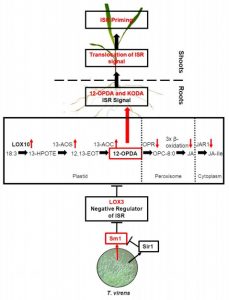 Plant roots communicate with microbes in a sophisticated manner through chemical communication within the rhizosphere, thereby leading to biofilm formation of beneficial microbes and resulting in priming of defence, or induced resistance in the plant host to a wide range of pathogens (induced systemic resistance, ISR). Trichoderma virens is an agriculturally-relevant root-colonizing fungus that provides its plant hosts many benefits, such as increased growth, destruction of soil-borne pathogens, and enhanced ISR. The signal communication between T. virens and host plants is poorly understood; ISR induction is supposed to depend upon the phytohormones ethylene and jasmonic acid (JA), one of hundreds of oxylipins. Lipoxygenases (LOX) are key enzymes in the biosynthesis of oxylipins and in particular LOX10 was described as a positive regulator of ISR. In this paper the authors analysed the xylem sap of T. virens-treated maize in order to determine potential ISR signals, by using ISR-positive and -negative mutants of both maize and T. virens. The screening revealed that accumulation of two oxylipins, the JA precursor (12-OPDA) and α-ketol (KODA) correlated with ISR activation in a dose-dependent manner. (Summarized by Francesca Resentini) Plant Cell 10.1105/tpc.19.00487.
Plant roots communicate with microbes in a sophisticated manner through chemical communication within the rhizosphere, thereby leading to biofilm formation of beneficial microbes and resulting in priming of defence, or induced resistance in the plant host to a wide range of pathogens (induced systemic resistance, ISR). Trichoderma virens is an agriculturally-relevant root-colonizing fungus that provides its plant hosts many benefits, such as increased growth, destruction of soil-borne pathogens, and enhanced ISR. The signal communication between T. virens and host plants is poorly understood; ISR induction is supposed to depend upon the phytohormones ethylene and jasmonic acid (JA), one of hundreds of oxylipins. Lipoxygenases (LOX) are key enzymes in the biosynthesis of oxylipins and in particular LOX10 was described as a positive regulator of ISR. In this paper the authors analysed the xylem sap of T. virens-treated maize in order to determine potential ISR signals, by using ISR-positive and -negative mutants of both maize and T. virens. The screening revealed that accumulation of two oxylipins, the JA precursor (12-OPDA) and α-ketol (KODA) correlated with ISR activation in a dose-dependent manner. (Summarized by Francesca Resentini) Plant Cell 10.1105/tpc.19.00487.



